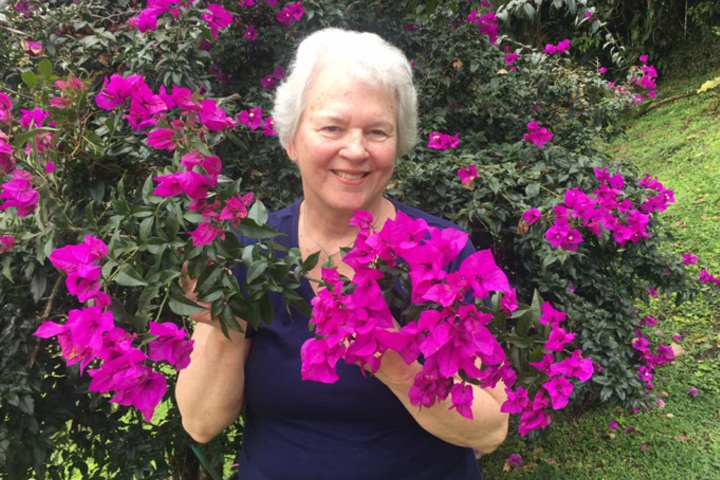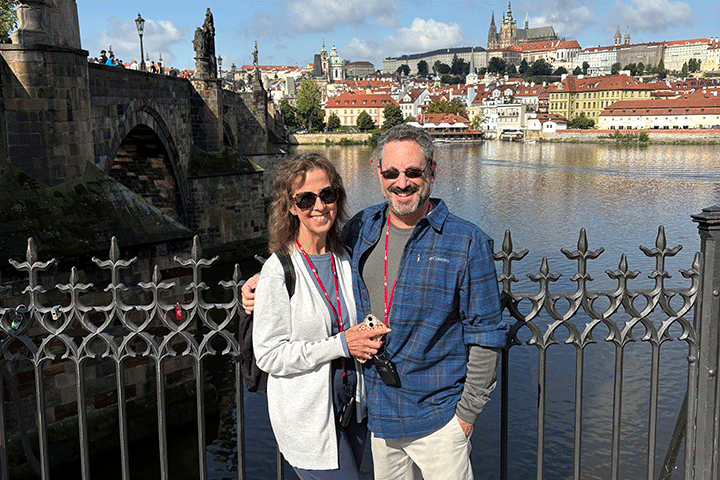Choosing the Strongest Chemotherapy for Pancreatic Cancer

- Bloating and pain eventually leads to discovery of a tumor
- Given three chemotherapy options; choosing FOLFIRINOX
- Chemo stops working; lung nodules appear
- Switching to a different chemotherapy combination
- Possible use of Lynparza for lung nodules
For several months I felt bloating and a dull pain in my lower abdomen. Many times after eating I found myself taking Mylanta. I never dreamed I was about to begin a cancer journey.
After a routine appointment my gynecologist told me to take probiotics to see if that would help the bloating and pain. When it did not help, I went to my GP who got right on it and found the reason for the pain and bloating within the same day. Initially, I had an ultrasound and CT scan on October 31, 2016. I was told that I had a mass of about 4 x 3 cm in the tail of my pancreas.
I then went for an MRI in Charlottesville at University of Virginia. A few weeks later, I had an endoscopy in which, as I understand it, they went down my throat and took a sample of the tumor in the pancreas. I was also told at the time of the MRI that there were a few spots on my liver that could hardly be detected. I was diagnosed with inoperable pancreatic cancer, stage IV, in November 2016.
Choosing a Treatment
Since my cancer was inoperable because of the location of the tumor (near the artery and in the tail of the pancreas) I was told that I should see an oncologist. I heard that a certain oncologist in my hometown of Lynchburg, Virginia, was “good” so I met with Dr. Kathleen Paul at Centra Alan B. Pearson Regional Cancer Center. After my appointment with Dr. Paul I decided to start pursuing information about the next steps. She told me that my health was very good, and I had a good chance with chemo if I opted to do that. She suggested three different chemotherapy options. At first, I almost decided not to have any chemo because I had heard so many negative things about pancreatic cancer and the outcome. But, after thinking about my options for a few days and the quality of life I still wanted to have, I chose treatment with FOLFIRINOX, the chemo that was the strongest and most toxic of all the chemos suggested.
In April 2017 I went to Johns Hopkins in Baltimore, Maryland to get a second opinion. I met with the “tumor board” there, and the doctors there were very helpful and knowledgeable. I was told that the best treatment I could get for this stage and location of the tumor and the kind of cells would be the FOLFIRINOX, as long as I could handle the side effects.
For the treatment I had to wear a pump for two days, then go back to the clinic, have it removed and have a shot of Neulasta. The side effects of FOLFIRINOX were very hard on me. I started taking Claritin (to counteract a side effect of the Neulasta) for five days the day I got the pump removed. I had nausea, although no vomiting, and starting at about day three I would have a terrible diarrhea attack with extreme pain in my lower abdomen from the chemo. I would then take two Imodium pills to stop the diarrhea. By day six or so, I would start to feel better, but I was still very tired.
I found that dehydration would really take its toll on me, so twice after the chemo treatment I would return to the clinic for a liter of fluid, which really helped. I found that for a few days after treatment the taste of food and water was very unappetizing, so the two liters of fluid really helped with this too. On top of this I had the “chemo fog” that goes along with treatment (a dullness mixed with nausea and extreme fatigue). I got and still have neuropathy in my feet, toes, and ankles. I lost very little hair so never really had to wear a wig. Overall, I do not have any pain or digestive disorders when I keep within my good eating habits and I take Creon three times a day.
I can truly say that aside from the horrific side effects from FOLFIRINOX, my quality of life was better than I ever expected. Several times if my platelet count was not high enough, I would not have a treatment right away, and that also helped my quality of life.
The treatment also affected my emotional state. In 2017, after a few months of chemo I got very sad, crying a lot, with weakness. My doctor put me on Lexapro and it has made a world of difference to everything I do. I also take Ativan every night which helps me relax and sleep well.
I had one other change to my life. I was a professional singer—I graduated with a music degree from college and have pursued a career in that ever since. Music is my passion and has been my livelihood, and I love to sing German lieder and sacred music. But I stopped singing “professionally” as of two years ago. My oncologist encouraged me so much to keep it up, but singing, as with a sport, takes your whole body’s energy and emotion. With the chemo side effects, singing the way I used to is no longer an option for me. I really don’t miss it since for so long I sang the way I really wanted to.
Should I Change my Plan?
After being treated for about one year with FOLFIRINOX, my tumor had shrunk and the tumor marker was very low. I went back up to Johns Hopkins to find out what their suggestions might be. I was told that there was a good “chance” that I would benefit from surgery to get rid of the tumor. There was then no trace of anything in the liver or anywhere else. However, this would be a “trial surgery” and before the surgery, I would have to have several rounds of intense radiation in a special machine designed to shrink the tumor even more. After that the surgery would take place. But the doctors kept referring to the surgery as a “trial.”
I was 76 then, and Johns Hopkins is a five- to six-hour drive from our home. I have felt all through this journey that quality of life is my priority, not experimenting with my body. I have had my share of surgeries in my life, and just thinking of being on “trial” with surgery, was not what I wanted. Surgery was not on my list of end-of-life activities. So, I opted not to have surgery, and I am still here to tell the story.
Time to Change Treatments
For nearly two years I tolerated this chemotherapy. But I found out in August 2018 that the chemo was no longer doing its job on the tumor. The pancreatic cancer metastasized and spread into my lungs in tiny nodules. I underwent genomic testing of my tumor and the following mutations were found: MSI Stable; PDL 1 0%; BRCA2 mutation; KRAS mutation; TP53 mutation.
Dr. Paul put me on another chemo combination of Gemzar and Abraxane. I did not tolerate the combination very well so she eliminated the Abraxane. I continue to have side effects, and this time I have lost my hair.
If my current treatment doesn’t bring good results, Dr. Paul would like to try a pill called Lynparza. It will still produce side effects that I will or will not tolerate. Only time will tell on that. But right now the chemotherapy is working, and my tumors are getting smaller.
About 10 months after sharing her story, Miriam passed away from pancreatic cancer. Her focus was on quality of life and how she spent her remaining time with her much-loved family. We offer our deepest sympathy and admiration for her choices.






